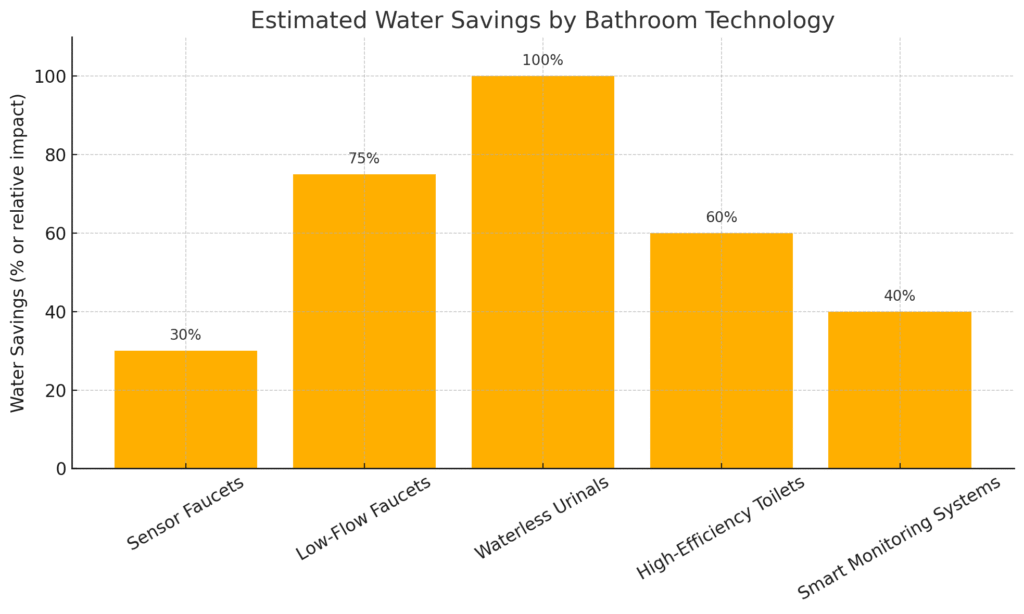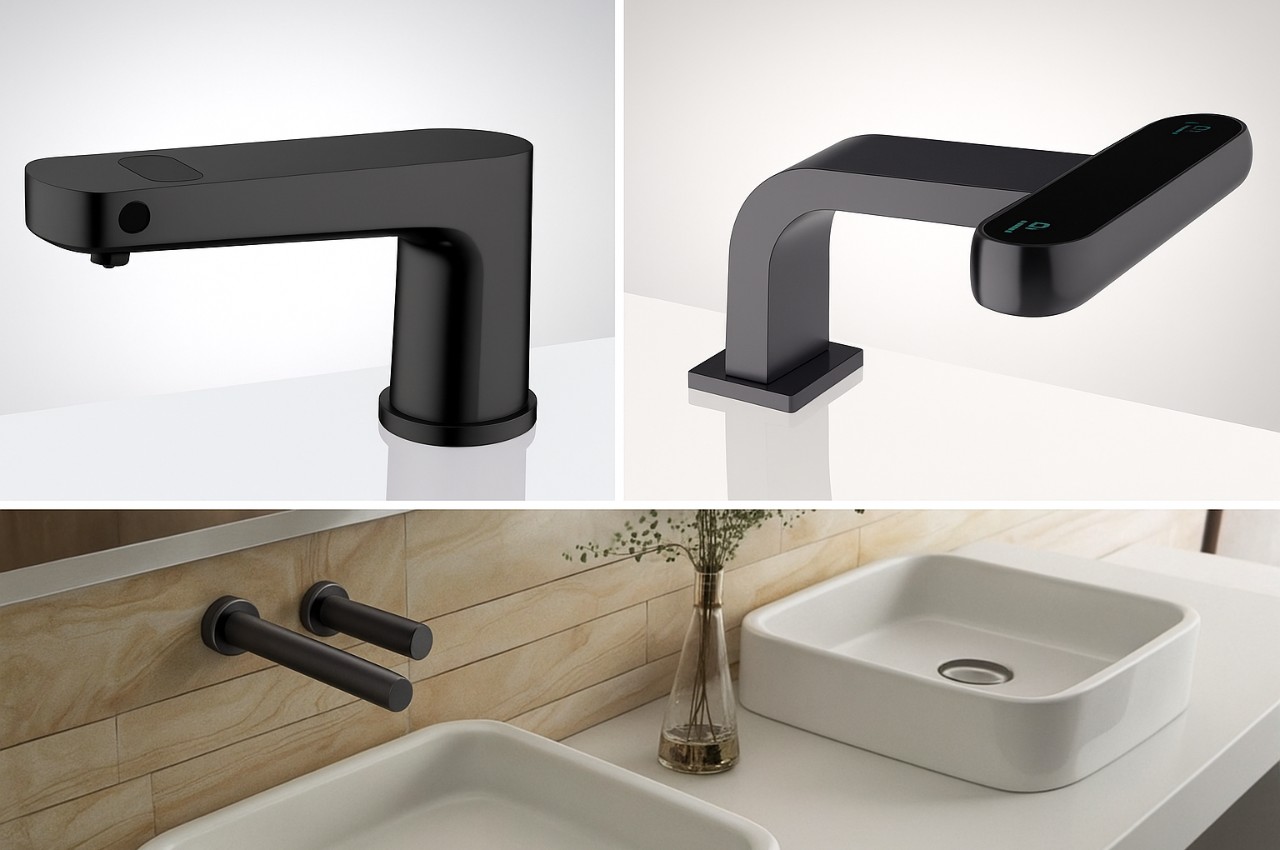Apart from being eco-friendly, water conservation these days is much more. Not only is conserving water easy on the environment, but it is also a necessity for reducing utility bills and keeping up with sustainability regulations for building managers, especially those managing high-traffic buildings like airports, schools, shopping centers, and corporate campuses. Public restrooms, which consume a tremendous amount of water daily, are the best place to put into practice state-of-the-art water-conserving technologies.
In this guide, we describe the key breakthroughs in water-conserving technologies, the benefits to building owners, and operating strategies for integrating without disruption.
🔗 Why Commercial Restrooms Waste Water – Alliance for Water Efficiency
Why Water Conservation in Public Restrooms Matters
Public restrooms are entered hundreds, sometimes thousands, of times a day. Each flush, faucet, or drip adds up—making bathrooms one of the most important aggregate water-using spaces in commercial buildings.
🔗 Understanding Commercial Restroom Usage – Zurn
If water-saving devices are not adopted, it can result in:
- Increased operating expenses
- Inability to meet LEED or other green certification goals
- Harmful brand image in environmental-aware markets
- More maintenance due to older plumbing systems
Through investments in smarter plumbing fixtures and better monitoring systems, building owners can drive a facility’s water use significantly lower while improving restroom performance.
🔗 Green Building Savings – U.S. Green Building Council
Important Water-Saving Technologies
- Sensor-Activated Faucets
These touchless faucets also save water through automatic turn-off when not being used. The more recent models feature adjustable flow rates for water and sensor ranges to make sure water is dispensed only when hands are present.
Benefits: Saves water, promotes cleanliness, and avoids flooding due to neglected taps.
🔗 Sensor Faucets for Public Use – FontanaShowers
- Low-Flow and Aerated Faucet Heads
Low-flow faucet aerators restrict water flow to a paltry 0.5 gallons per minute (GPM), while typical models use 2.2 GPM. Aerators mix air with water in order to provide the same perceived pressure through less water overall.
Benefit: Saves as much as 75% of water without affecting user experience.
🔗 Low-Flow Aerators – Niagara Conservation
- Waterless Urinals
Waterless toilets work on a chemical trap or gravity drain system and require no flushing whatsoever. Modern designs are odor-free and highly sanitary when maintained properly.
Benefit: Saves up to 40,000 gallons of water per urinal annually. Ideal for stadiums, airports, and schools.
🔗 Waterless Urinals Guide – Falcon Waterfree
- High-Efficiency Toilets (HET)
HETs use 1.28 GPF or less, while much older designs used as much as 3.5 GPF. Dual flush toilets offer further saving because the user may choose a low flush or full flush according to the type of waste.
Benefits: Water saving, rebate from the local utility, and new design.
Touch-free flush valves turn on automatically with each use, offering equal performance. The majority are programmable to manage timing and duration of flushing.
🔗 High-Efficiency Toilets – American Standard
- Smart Restroom Monitoring Systems Smart Restroom
Monitoring Systems track water consumption, leaks, and fixture life in real-time. They can alert maintenance staff to issues like running toilets or malfunctioning valves before they have the opportunity to fail catastrophically.
Benefits: Enables proactive maintenance, prevents water waste, and enables monitoring of conservation activity.
🔗 Smart Restroom Monitoring – KOHLER
Benefits for Building Owners
Cost Savings
Water-saving devices can reduce water bills 30–50%. Over time, this may be worth tens of thousands of dollars—particularly for large or busy buildings.
🔗 Commercial Savings from Green Plumbing – Green Building Advisor
Compliance and Certifications
Green building regulations such as LEED (Leadership in Energy and Environmental Design), WELL, and city water conservation regulations recognize and reward buildings with water-saving infrastructure. Certifications will enhance a building’s marketability and attract environmentally conscious tenants.
🔗 LEED Water Efficiency Credits – USGBC
Maintenance and Durability
Many newer fixtures, especially sensor-controlled ones, are fashioned with tamper-proof and low-maintenance technology. They deter vandalism and lower the break-down rate compared to standard fixtures.
🔗 Durable Public Fixtures – Bobrick
Environmental Responsibility
Conservation of water is in keeping with regional conservation goals, reduces reliance on municipal infrastructure, and positions the building owner as an environmentally sensitive steward of the world.
🔗 Sustainable Water Management – EPA

Implementation Tips for Success
- Performs a Water Audit
Start by checking current water usage in toilets. Check for high-use fixtures and potential leaks. Utility staff or green building experts can assist with this.
🔗 How to Conduct a Water Audit – Alliance for Water Efficiency
- Select Proper Products
Find fixtures that carry approvals such as WaterSense (by the EPA), which guarantee performance and efficiency. Brand reputation and length of warranty are also important considerations.
🔗 WaterSense Product Search – EPA
- Plan Maintenance
Even advanced fixtures require periodic maintenance. Arrange for regular inspections and instruct custodial personnel on maintaining sensor parts and aerator or cartridge replacement.
🔗 Maintenance for Commercial Restrooms – Sloan
- Educate Users
Simple postings describing the advantages of water-saving fixtures promote courteous use and can enhance your public reputation.
🔗 Promote Green Restrooms – GreenBiz
- Take Advantage of Incentives
Check with local utilities regarding rebates or tax credits on the installation of water-saving technologies. These can offset costs of the initial investment.
🔗 Rebate Finder – EPA WaterSense
- Looking Ahead: The Future of Smart Restrooms
The future is smart and sustainable. AI-powered systems, predictive maintenance, and cloud-hosted usage dashboards will become the standard in public restroom design. Early adopters of these technologies will reap lower costs, enhanced tenant satisfaction, and a clear competitive edge.
🔗 The Future of Restroom Design – ArchDaily
Conclusion
Upgrading to water-conserving technology in public restrooms isn’t just a going-green initiative—it’s sound business. From reduced utility bills to improved hygiene and enhanced sustainability goals, the return is undeniable. If you operate a commercial high-rise or community recreation facility, these technologies can pay with long-term dividends for your building and the environment.
🔗 Commercial Restroom Efficiency Guide – BuildingGreen
💧 Water-Saving Public Bathroom Technologies Overview
| Technology | Description | Key Features | Benefits |
|---|---|---|---|
| Sensor-Activated Faucets | Touchless faucets that turn on only when hands are present | Adjustable flow rate, motion sensor range | Reduces water waste, promotes hygiene, prevents flooding |
| Low-Flow & Aerated Faucet Heads | Faucets that restrict flow and mix air with water | Flow as low as 0.5 GPM, maintains pressure | Saves up to 75% water, user comfort maintained |
| Waterless Urinals | Urinals that do not require flushing | Chemical trap or gravity system, odor-control design | Saves ~40,000 gallons/year/unit, ideal for high-traffic areas |
| High-Efficiency Toilets (HETs) | Toilets using 1.28 GPF or less | Dual-flush options (light/full), modern designs | Reduces water use, qualifies for rebates, stylish & efficient |
| Touch-Free Flush Valves | Automatically flush after each use | Sensor-based, programmable timing | Enhances hygiene, prevents over-flushing, reduces contact contamination |
| Smart Restroom Monitoring Systems | Tracks water use and fixture performance in real-time | Leak detection, lifespan monitoring, alerts for maintenance issues | Enables proactive repairs, reduces waste, improves system oversight |
🏢 Benefits for Building Owners
| Category | Details |
|---|---|
| 💰 Cost Savings | 30–50% reduction in water bills; long-term ROI for high-usage buildings |
| 🏅 Certifications | Helps achieve LEED, WELL, and other green standards; improves building marketability |
| 🔧 Maintenance | Tamper-proof, durable fixtures require less upkeep; fewer plumbing breakdowns |
| 🌍 Sustainability | Supports environmental goals; reduces load on municipal systems; improves corporate image |

No responses yet